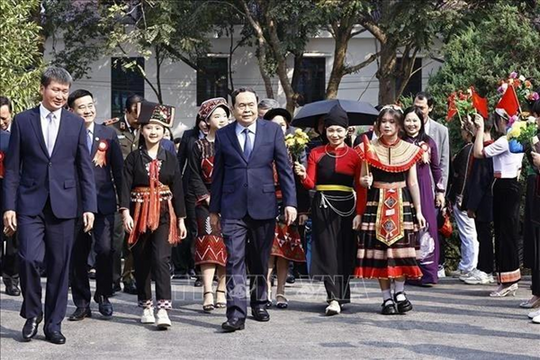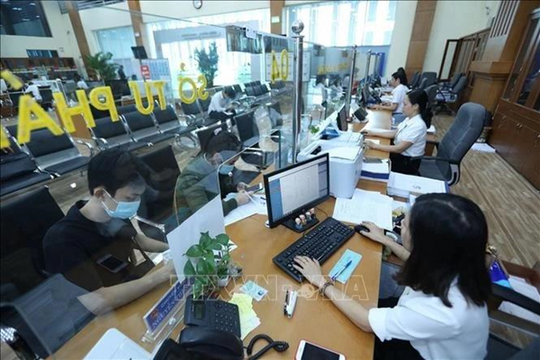 |
| A drone sprays pesticides on a local rice field in the Mekong Delta province of Kiên Giang.— VNA/VNS Photo Lê Sen |
KIÊN GIANG — The use of unmanned aerial vehicles (drones) for spraying pesticides, sowing seeds and fertilising rice fields has gained rapid momentum in the Mekong Delta provinces in recent years.
However, the question of how to safely integrate drones into agricultural production has become a significant concern, particularly following a fatal accident in the Hòn Đất District of Kiên Giang Province on November 20.
Quỳnh Văn Hai, a resident of Thuận Hưng Commune in Mỹ Tú District, Sóc Trăng Province, said that rice farming has become much less labour-intensive and drones play a vital role.
From land preparation and sowing to harvesting, the majority of tasks were now carried out by machinery, saving both time and significant costs.
Hai was particularly enthusiastic about the application of drones for pesticide spraying.
In a typical rice crop, if there were good seeds and favourable weather conditions, at least three and four pesticide applications were needed.
In years with adverse weather or heavy pest attacks, the number of sprayings might increase.
"Everyone knows that directly spraying pesticides is harmful to human health, but without it, pests will destroy the crops and impact yields.
"Therefore, using drones to spray pesticides is seen as a revolution that helps farmers avoid health risks as they grow older,” he said.
He also said that the cost of hiring drone services was relatively affordable so it is convenient to call them whenever needed.
“All I need to do is prepare the chemicals and they handle the mixing and spraying,” he said.
Not only was it quick, but spraying with the devices was also more uniform and efficient, leading to higher crop yields, he added.
Drone services
Trương Triệu Phú, head of the 'Phi Công Trẻ (Young Pilot)' drone team in Tri Tôn District, An Giang Province, talked to Tuổi trẻ (Youth) online newspaper telling them he owned six drones for agricultural use.
He was the first in the province to offer drone services for pesticide spraying, seed sowing and fertilisation.
After purchasing two drones in late 2019, priced between VNĐ500-600 million (U$S19,600-23,600) each, he realised the potential for profit and expanded his fleet to over ten drones.
However, as the number of drone operators surged in the province, the cost of services and income has decreased.
At first, drone operators could earn over VNĐ10 million ($393) per month; now, their earnings average around VNĐ6-7 million ($236-375) per month.
"When I started, I charged VNĐ180,000 ($7) per ha. Now, due to the influx of drones, the price has dropped to VNĐ120,000 ($4.7) per hectare,” he said.
However, the cost of drones has also fallen, with many now priced around VNĐ300 million ($11,800) each.
According to Phú, each drone requires two operators, and a drone can cover around 500 ha of rice fields per day, generating approximately VNĐ90 million ($3,500) in monthly income.
After deducting expenses, including wages for workers, the operator could expect a profit of VNĐ60 million ($2,360) per month.
 |
| A local farmer in An Giang Province uses a drone to spray pesticides to control brown planthoppers.—VNA/VNS Photo Công Mạo |
Ensuring safety
As more people invest in drones for agricultural services, managing safety has become increasingly challenging.
Phú stressed the importance of training and regular safety assessments for drone operators.
Each drone should need about 10-15 minutes to spray or sow per hectare; however, some pilots fly recklessly, returning too quickly without proper observation, which increases the risk of accidents, he said.
Even though the team thoroughly trained operators to land on temporary fields and avoid landing on roads or near high-voltage lines, some still ignored the precautions, which was very dangerous, he said.
He said agricultural drones had experienced rapid growth in the Delta, regulation and oversight remained insufficient.
“Farmers looking to hire drone services should ensure safe landing sites to prevent accidents, avoiding those involving power lines or people,” he said.
Nguyễn Văn Út from Khánh Bình Commune, Trần Văn Thời District in Cà Mau Province, highlighted the importance of caution when operating drones.
"When I fly a drone, I always pay attention to the people around me, and I have someone to keep watch to ensure no one gets too close to the takeoff and landing areas. I typically launch the drone in areas with minimal traffic to ensure safety."
Lê Phú Luân, another local farmer in Trần Hợi Commune, Cà Mau Province, said he knew the convenience of using drones for pesticide spraying, but also recognised the potential dangers.
"Whenever I hire a drone service, I remind my children not to go near the machine while it's operating. This is one way to ensure safety for both the drone operators and surrounding people," he said.
Investigation continued
The local authorities in Mỹ Hiệp Sơn Commune, Hòn Đất District, Kiên Giang Province, are still investigating a fatal accident involving a drone operator, who collided with a pedestrian named B.V.T. that was walking along the road and later died from the incident on November 20.
As of the latest figures, the province has more than 690 agricultural drones, with Hòn Đất District leading with 231 drones, followed by Giang Thành District with 141 drones and Giồng Riềng District with 115 drones.
A representative of the Kiên Giang Agricultural Extension Centre said that drones imported into Việt Nam were required to register with the Ministry of National Defence for operational permits, which were valid for six months.
When the permit expired, the importing company must renew the registration.
The centre had organised training sessions for drone owners to ensure safe pesticide spraying practices and efficient use of resources.
"The high number of drones in the province is due to the province's vast rice fields and high production output, making drones a convenient solution to address the shortage of labour," he said.
Following the accident in the province, several provinces in the delta had issued directives to track drone ownership and ensure operators follow safety protocols.
On November 27, the National Assembly approved the Law on People's Air Defence, which now includes detailed regulations on the management of drones and other flying vehicles.
Notably, the new law stipulated that drones must be registered before use in agricultural production, ensuring a safer environment for both operators and the general public.— VNS
























